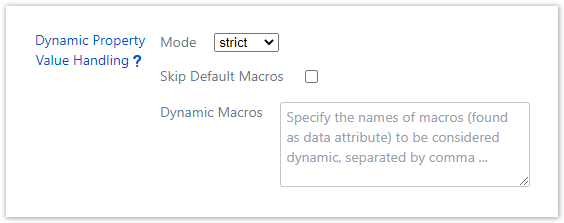- Created by Robert Reiner, last modified on 22. Feb 2024
projectdoc Toolbox
Configuration to control how the projectdoc Toolbox handles property values with dynamic content.
- Audience
- Type
- Level of Experience
- Since
- 6.0
The use of dynamic content for property values is typically a problem. The projectdoc Toolbox provides since version 6.0 tools to help responsible stakeholders to manage the use of dynamic content in their information architecture.
This topic shows the configuration options and provides links to further information.
Prerequisites
Dynamic property values is content that changes at request time. For most use cases, property values should be static and only change when the document is saved. This does not include static references from one document to another, since these dependencies are tracked by the projectdoc Toolbox and dependent documents are updated accordingly.
For more information on this subject, please refer to Dynamic Property Values.
Configuration Options
Via the graphical user interface administrators have the following options to control the handling of dynamic property values in their Confluence instance.

After changing the mode a refresh of the site is required.
Mode
The mode controls the general handling of values.
The modes lenient and strict are recommended to be used as runtime modes.
The mode allow is for backward compatibility only. It puts no restriction to the use of dynamic values. It is recommended to check the spaces with projectdoc documents with the health services to learn, which mode may be most appropriate for the current use of properties in projectdoc documents.
The modes explicit and block are typically only used to find possible issues using the health service.
| Mode | Description |
|---|---|
off | No restriction. Not recommended. This mode is used for backward compatibility. |
allow | Restriction only to use macros that are not designed to be used as a property value. For instance using a properties table or a wiki link macro. Dynamic values are allowed. Users are responsible to use them correctly. This mode is used for backward compatibility. |
lenient | Dynamic values are allowed, and if proper controls are not set, then no-property is assumed. The following controls are considered proper: Health checks will signal the use of deprecated features of macros considered to be dynamic. This mode may be selected to allow users to use dynamic values. |
strict | Dynamic values are allowed if proper controls are set. The following controls are considered proper: This mode will be the default mode for the next major version of the projectdoc Toolbox. It is the recommended mode for new users. |
explicit | Dynamic values are allowed, if proper controls are set: The implicit flagging of no-property when a dynamic property is encountered, is not allowed. This mode should only be used for testing the health of documents, not as a runtime mode. |
block | No dynamic value is allowed. This mode may be helpful to find all locations of dynamic values with a health check. Not recommended as a runtime mode. |
Table: Modes provided on Dynamic Property Values
Skip Default Macros
The projectdoc Toolbox defines macros that must be treated as dynamic if used as property values in projectdoc documents.
In case you do not agree with this definition, you may switch off this configuration (setting a check to Skip Default Macros) and do the definition of dynamic macros completely on your own.
It is recommended to keep this checkbox unchecked and therefore take advantage of the default configuration.
Dynamic Macros
List additional macros users of Confluence are using, especially as values of document properties.
The list contains the identifier of the macros considered to be dynamic, separated by comma. These macro identifiers can be found in the storage format of the macro definition and maybe in the documentation of the macro.
When projectdoc encounters such a macro as value of a property, then the property value is treated as a dynamic value that requires special handling dependent on the selected Mode.
Resources
More information on this topic is available by the following resources.
- Dynamic Property Values
- Property values should only change when a document is saved. They should not be dependent on request-time. If they are, then they are called 'dynamic'.
- no-property
- Controls whether a line in a document properties marker macro is actually a property.
- force-property
- Enforces to treat a property with dynamic value as property.
- noindex
- Prevents the property from being indexed with Lucene. A property marked with this control will neither be added with a keyword nor added to the body of the document as text.
- no-render-cache
- Controls whether or not a rendered property value can be cached.
- No dynamic Property Values
- The projectdoc Toolbox does not support dynamic values as property values. Use sections to render dynamic values and select the contents of this section instead of property values.




